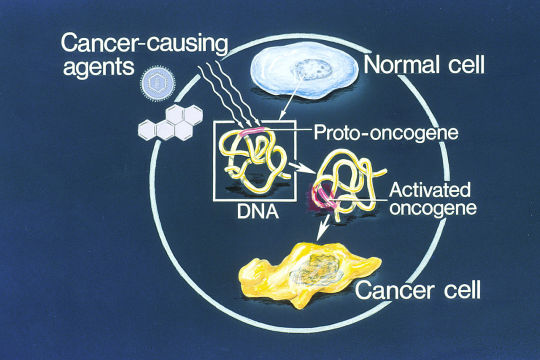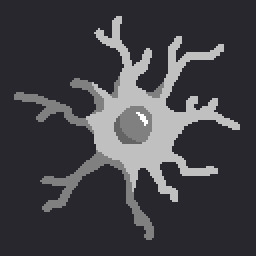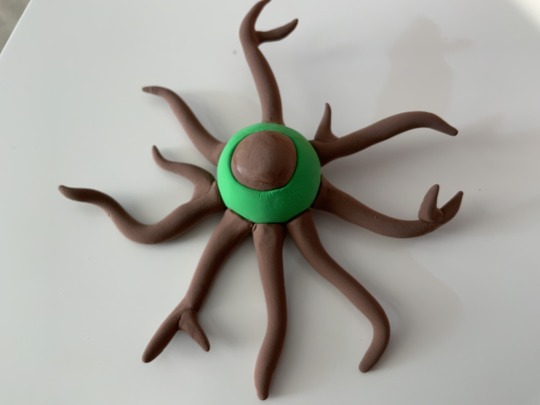#dendritic cell
Text



Synaps! (He/Him)
He’s the boss of my white blood cell ocs. He’s a tyrannical dendritic cell who hates disappointment.
He uses electric shocks for communicating orders and attacks.
#immune system#white blood cell#cell oc#speculative biology#dendritic cell#leucocytes#original character#character design#scopnotart
86 notes
·
View notes
Text



older CaW art I forgot to post… (around 3 months ago 😭)
#digital art#procreate#my art <3#rkgk#fanart#cells at work fanart#cells at work#はたらく細胞#hataraku saibou#hataraku saibou fanart#killer t cell#helper t cell#regulatory t cell#nk cell#eosinophil#dendritic cell#macrophage#B cell
73 notes
·
View notes
Text
I asked my friend to bald dendritic cell so i can edit him with a low taper fade
18 notes
·
View notes
Text


Propaganda!
A dendritic cell (DC) is an antigen-presenting cell (also known as an accessory cell) of the mammalian immune system. A DC's main function is to process antigen material and present it on the cell surface to the T cells of the immune system. They act as messengers between the innate and adaptive immune systems.
An oncogene is a gene that has the potential to cause cancer. In tumor cells, these genes are often mutated, or expressed at high levels. Most normal cells will undergo a programmed form of rapid cell death (apoptosis) when critical functions are altered and malfunctioning. Activated oncogenes can cause those cells designated for apoptosis to survive and proliferate instead.
#tournament poll#polls#wikipedia#cells of the human body#science tournament#dendritic cell#oncogene#image descriptions in alt text
10 notes
·
View notes
Text
I HC that Macrophage and Dendritic cell are QPR
#just love the idea of aroace macrophage and dentritic cell#dendritic cell#macrophage#cells at work#hataraku saibou
2 notes
·
View notes
Text
So I bought the art book and I have Answers™
AE3803 160cm/ 5' 3"
U1146 180cm / 5' 11"
Platelets 90cm / 2' 11.5"
Killer T 190cm / 6' 3"
NK 175cm / 5' 9"
Dendritic 170cm / 5' 7"
Macrophage 170cm / 5' 7"
Eosinophil 160cm / 5'3"
Basophil 180cm / 5' 11"
Cancer 150cm / 4' 11"
Helper T 175cm / 5' 9"
Regulatory T 170cm / 5' 7"
Mast Cell 165cm / 5' 5"
B Cell 168cm / 5' 6"
Memory B Cell 162cm / 5' 4"
Normal Cell 155cm / 5'1"
Observations:
Looks like Cancer might be slightly stunted.
1146's height is a good estimate for the rest of the squad since they're all the same height. By extension, 7776 (band cell) from White Brigade is estimated at about 165cm~170cm range.
Otherwise it looks like most of them grew up pretty well. Quite uniform in height, coloration and general builds for their cell type (minimal to no stunting/wasting/abnormal coloring) so the host body of main is likely pretty well cared for, they just got unlucky with all the infections and health problems.
Memory B might have just a bit of stunting that might be attributed to his high stress and poor stress management habits. Poor guy.
#hataraku saibou#cells at work#hataraku saibō#hataraku saibou manga#cells at work white#ae3803#u1146#dendritic cell#macrophage#basophil#eosinophil#killer t cell#cancer cell#normal cell#nk cell#platelet#helper t cell#regulatory t cell#mast cell#memory cell#b cell#cells at work white brigade#white blood cells at work#hataraku saibou white#band cell#7776
73 notes
·
View notes
Text


Dendritic cells I made in paint, I think they're cute
#art#my art#artists on tumblr#biology#cell biology#dendritic cell#cytology#ms paint#ms paint art#microsoft paint
14 notes
·
View notes
Text
You are a Dendritic Cell
You're very curious and your fascination with the world around you drives you to constantly seek new experiences. You also thrive in social settings and always have something new to show off to your friends, whether they're new experiences or trinkets from your recent travels.
16 notes
·
View notes
Text

I just made a clay dendritic cell model while listening to Lapfox Trax because why the heck not? also this will probably be my only post on here lol
#dendritic cell#cells#cell biology#dendritic#antigen presenting cell#dendrite#E#I spent 20 minutes of my life on this
2 notes
·
View notes
Text
Dendritic Cell Therapy: Reengaging the Power of the Immune System in Cancer Treatment

Dendritic cell therapy, a cutting-edge form of immunotherapy, has emerged as a beacon of hope in the realm of cancer treatment. This groundbreaking approach harnesses the body's own immune system to combat cancer. In this article, we will explore the intricacies of dendritic cell therapy, covering what it is, how it works, the types of cancers it can address, the drugs used, and the precautions and benefits of this innovative treatment.
What are Dendritic Cells?
Dendritic cells are a type of immune cell with a unique ability to recognize foreign invaders like viruses, bacteria, and cancer cells. They act as sentinels of the immune system, capturing antigens from these invaders and presenting them to other immune cells. Dendritic cells are crucial in initiating and regulating the immune response, making them key players in dendritic cell therapy.They are the only cells of the immune system that can initiate antigen-specific immune responses.The dendritic cell was discovered by Ralph Steinman in 1973. Steinman, a physician- scientist at the Rockefeller University, New York, thought of using these cells in fighting diseases including HIV and cancer.
What is Dendritic Cell Therapy?
In cancer, the immune system fails; cells of the immune system fail to recognize the cancer cells. Dendritic cell therapy is a form of immunotherapy that revolves around the utilization of dendritic cells to activate the patient's immune system against cancer. Dendritic cells play a pivotal role in the immune system, acting as messengers that recognize and present antigens to other immune cells, such as T-cells. In cancer treatment, dendritic cell therapy aims to stimulate the immune response against cancer cells, effectively "training" the body to recognize and attack them.
How Dendritic Cell Therapy Works?
Dendritic cell therapy operates through a series of intricate steps:
Dendritic Cell Collection: Dendritic cells are harvested from the patient's blood or tumor tissue.
Dendritic Cell Activation: In the laboratory, these dendritic cells are exposed to cancer-specific antigens, effectively preparing them to recognize cancer cells.
Reinfusion: The activated dendritic cells are then reintroduced into the patient's body, where they serve as messengers, alerting the immune system to the presence of cancer.
Immune Response: Once activated dendritic cells encounter cancer cells, they stimulate the immune system, especially T-cells, to target and destroy the cancerous cells.
Types of Cancers that Can Be Cured with Dendritic Cell Therapy
Dendritic cell therapy has shown promise in treating various types of cancers, including but not limited to melanoma, prostate cancer, kidney cancer, and certain forms of leukemia. It is particularly effective in cancers that are known to have a strong immune response.
Drugs Used in Dendritic Cell Therapy
Dendritic cell therapy is often used in combination with other immunotherapies, such as checkpoint inhibitors (e.g., Pembrolizumab and Nivolumab) and cytokines like Interleukin-2. These drugs enhance the immune response and the effectiveness of dendritic cell therapy.
Precautions and Benefits of Dendritic Cell Therapy
Precautions:
Patient Selection: Dendritic cell therapy may not be suitable for all patients. A thorough evaluation is necessary to determine eligibility.
Side Effects: Common side effects include fever, chills, fatigue, and injection site reactions, but they are typically mild and short-lived.
Monitoring: Close monitoring of the patient's response and any potential adverse effects is crucial during and after treatment.
Benefits:
Enhanced Immune Response: Dendritic cell therapy strengthens the patient's immune system, potentially leading to a more effective and sustained response against cancer.
Low Toxicity: Compared to some traditional cancer treatments, dendritic cell therapy is generally well-tolerated and has fewer severe side effects.
Personalized Treatment: The therapy can be tailored to the individual patient, focusing on their specific cancer type and characteristics.
Promising Results: Dendritic cell therapy has shown significant promise in clinical trials and real-world applications, with some patients experiencing long-lasting remissions.
Conclusion
Dendritic cell therapy represents a groundbreaking approach in the fight against cancer. By harnessing the body's immune system, it offers a personalized and low-toxicity treatment option for various types of cancer. While it is not a guaranteed cure, the potential benefits and promising results make it a beacon of hope in the quest to improve cancer treatment outcomes. Patients considering dendritic cell therapy should work closely with their healthcare providers to explore its suitability as part of their treatment plan.
0 notes
Text
sorry no drawings and maybe none tomorrow when I'm sick my motivation is too
13 notes
·
View notes
Text
i have this "anatomy of the brain" poster in my room and noticed one of the cells looked like an overseer. so i have done some digging
microscope images don't really look like overseers or the diagram on my poster, but i did learn something
the cell was a microglia cells are the immune system of the central nervous system. they are the brain's and spinal cord's first responders to threats and normally help brain regulation, maintain neural networks, and help in repairing injuries. honestly if you know what macrophages are, these cells are them but more specialized
and like macrophages, microglia cells are also known to scavenge. they find foreign material, dead and/or injured cells, brain-specific problems, and clean them up
iterators have a lot of brain/neuron imagery, so i feel at least some of this is intentional. i think the scavenging is a coincidence but interesting nontheless
#broadcast.txt#fun fact my special interest is the immune system#not any specific reigon but all of it entirely#i do not know all the names of every different type of macrophage or dendritic cell or whatever#but golly gee i love those cells#i made ocs out of it hehe
39 notes
·
View notes
Text

Are there any Cells at Work fans out there?
33 notes
·
View notes
Text
U1146 : Do you know why Killer T is so against dating within the body?
Dendritic Cell : Oh it's just that Killer T is a coward who's still stuck in his love/hate relationship with NK cell and can't stand to see anyone else happy.
U1146 : ...
Killer T : ...
Dendritic cell : Hello Killer T!
Killer T : I AM NOT IN LOVE! *leave in the other direction*
Dendritic cell : Haha! Young people nowadays!
U1146 : (Did he really need to destroy him like this though?)
34 notes
·
View notes
Text

[ Dendritic cell (Cells at Work! ) moodboard with microbes, cats, and a green or black/white/grey theme ]
I did mentioned in the first moodboard for this request that I had some extra photos, I kept on hesitating on posting it but here we are [:
Dear Mr. Dendritic Cell, if you see this then surprise, I guess !
10 notes
·
View notes
Text
Immunity Light Show
Newly developed fluorescent tag strategy called FlAsH enables live monitoring of T cells of the immune system interacting with specific antigen being presented to them by dendritic cells
Read the published research article here
Video from work by Munir Akkaya and Jafar Al Souz, and colleagues
Pelotonia Institute for Immuno-Oncology, The Ohio State University, Columbus, OH, USA
Video originally published with a Creative Commons Attribution 4.0 International (CC BY 4.0)
Published in eLife, January 2024
You can also follow BPoD on Instagram, Twitter and Facebook
10 notes
·
View notes